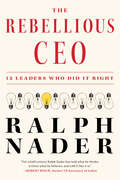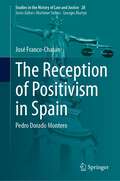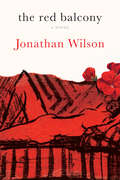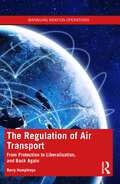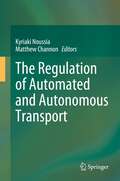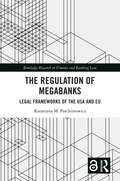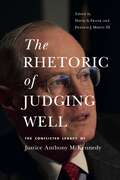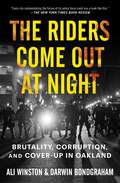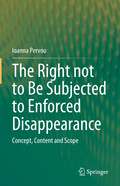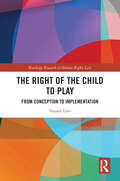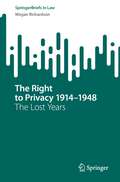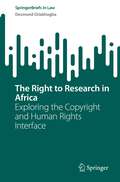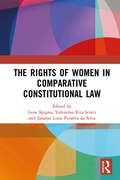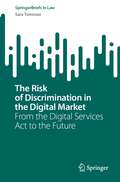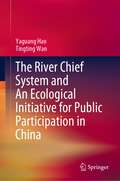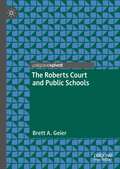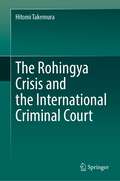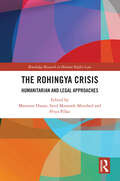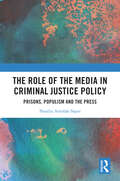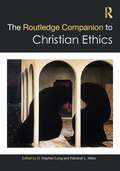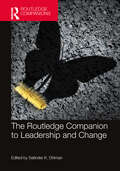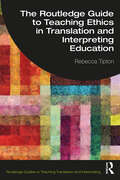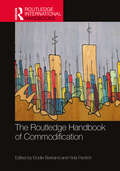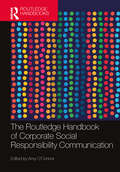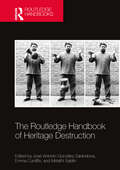- Table View
- List View
The Rebellious CEO: 12 Leaders Who Did It Right
by Ralph NaderOne of corporate America's greatest foes shows how 12 CEOs he has known uniquely rejected narrow yardsticks of shareholder value by leading companies to larger models of prosperity and justiceOver the course of 7 decades Ralph Nader has been Corporate America&’s fiercest critic. Supreme Court Justice William Powell singled out Nader in his infamous memo as the &“single most effective antagonist of American business… [the] target of his hatred… is corporate power.&”But now, in a book that will surprise both his fans and critics, Nader profiles a small group of CEOs who he believes performed extraordinarily well as business leaders and civic reformers, some well-known, some not, who should be celebrated as exceptions whose life and career should be a course of emulation and inspiration for students of business, executives and the wider citizenry. This select group of mavericks and iconoclasts — which includes The Body Shop&’s Anita Roddick, Patagonia&’s Yvon Chouinard, Vanguard&’s John Bogle and Busboys and Poets' Andy Shallal —give us, Nader writes, &“a sense of what might have been and what still could be if business were rigorously framed as a process that was not only about making money and selling things but improving our social and natural world.&”
The Reception of Positivism in Spain: Pedro Dorado Montero (Studies in the History of Law and Justice #28)
by José Franco-ChasánPedro Dorado Montero was one of Spain’s most relevant authors. He contributed to modern Criminal law and Penology with a very unique theory: the Protective Law for Criminals. In a time when neoclassical penal theories and new positivist theories clashed, Dorado Montero’s proposal served as a bridge between the criminal law conceptions of the 19th and 20th centuries.In order to explore his role in the introduction of positivism within Spain and the subsequent success of this trend, this book addresses several aspects. The first three analyzed are his scholarly career, the historical and international context in which he lived, and the various European and other international influences he was exposed to. On this basis, two major points are then discussed.Firstly, Dorado Montero has been traditionally included within the movement known as correccionalismo. However, his legal-philosophical and criminal thought indicates otherwise. It seems to lie closer to positivism than to neoclassical positions. This research aims at challenging the accuracy of the ‘eclectic’ label which traditional historiography has applied to him.In turn, Dorado Montero described a reality in which every moral value and legal representation was a mere product of mankind’s imagination. Man is responsible for the elaboration of morals, law and culture in his own mind. Thus, for him, there were as many moral and legal orders as there were human beings on the planet. Such a claim is polemic even today. Unsurprisingly, the author received criticism from both neoclassical and positivist schools. Thus, the existence of a ‘Doradian positivism’ is explored. Despite the growing interest in these topics over the last few decades, Dorado Montero has somehow been overlooked – even though his Derecho protector de los criminales described the criminal law of the future as well, one that will have to face the new neurological, medical, psychological and genetic challenges of our time.
The Red Balcony: A Novel
by Jonathan WilsonBased on actual events, a gripping novel of sex, love, history and justice in the tinderbox of British Mandatory Palestine, by the acclaimed author of A Palestine Affair"The story of what is arguably Israel&’s foundational murder trial—a tale of multiple identities and loyalties." —Joshua Cohen, Pulitzer-Prize-winning author of The Netanyahus It&’s 1933, and Ivor Castle, Oxford-educated and Jewish, arrives in Palestine to take up a position as assistant to the defense counsel in the trial of the two men accused of murdering Haim Arlosoroff, a leader of the Jewish community in Palestine whose efforts to get Jews out of Hitler&’s Germany and into Palestine may have been controversial enough to get him killed. While preparing for the trial, Ivor, an innocent to the politics of the case, falls into bed and deeply in love with Tsiona, a free-spirited artist who happened to sketch the accused men in a Jerusalem café on the night of the murder and may be a key witness. As Ivor learns the hard way about the violence simmering just beneath the surface of British colonial rule, Jonathan Wilson dazzles with his mastery of the sun-drenched landscape and the subtleties of the warring agendas among the Jews, Arabs, and British. And as he travels between the crime scene in Tel Aviv and the mazelike streets of Jerusalem, between the mounting mysteries surrounding this notorious case and clandestine lovemaking in Tsiona&’s studio, Ivor must discover where his heart lies: whether he cares more for the law or the truth, whether he is more an Englishman or a Jew, and where and with whom he truly belongs.
The Regulation of Air Transport: From Protection to Liberalisation, and Back Again (Managing Aviation Operations)
by Barry HumphreysThe regulation of modern civil aviation can be traced back to the later years of the Second World War. An intense debate about the future regulatory regime resulted in a compromise which to this day essentially dictates the structure of the global airline industry. Further progress towards ‘normalising’ the industry appears to be slowing down, and perhaps even going into reverse. Without an understanding of the development of regulation, it is not possible to understand fully the industry’s current problems and how they might be resolved. Many books have been written about the development of international air transport, covering deregulation, privatisation, the emergence of new business models among other things, but few if any have taken a broad view of the trends which have determined the industry’s current structure. The Regulation of Air Transport charts the development of aviation from the end of the Second World War to the present day, following the key trends and disruptive forces. It provides an overview of what has determined the industry’s current structure, the problems still facing the industry and the ways in which it could develop in the future. This wide-ranging study is important reading for both professionals and academics within the aviation field, as well as anyone interested in the broader development of economic regulation.
The Regulation of Automated and Autonomous Transport
by Kyriaki Noussia Matthew ChannonThis book discusses various legal aspects of automated and autonomous transport. The regulation of automated and autonomous transport encompasses legislation on automated cars, ships, vessels, and drones. Questions surrounding this novel area of the law, which has attracted major worldwide interest and publicity, are likely to dominate our societies and everyday life in the years ahead. One major challenge addressed in this book is remedying the regulatory fragmentation that can be observed around the globe concerning legislation on automated and autonomous transportation systems. Written and edited by respected experts in the field, including academics and practitioners alike, this book seeks to fill an important gap in the literature.Given its focus and scope, the book will be of considerable interest to practitioners, academics, and policymakers, judges, students and secondary audiences, including engineers, sociologists, naval architects, all those involved in the automated industry, and people working in AI.
The Regulation of Megabanks: Legal frameworks of the USA and EU (Routledge Research in Finance and Banking Law)
by Katarzyna ParchimowiczGlobal systemically important banks (G-SIBs) are the largest, most complex and, in the event of their potential failure, most threatening banking institutions in the world. The Global Financial Crisis (GFC) was a turning point for G-SIBs, many of which contributed to the outbreak and severity of this downturn. The unfolding of the GFC also revealed flaws and omissions in the legal framework applying to financial entities. In the context of G-SIBs, it clearly demonstrated that the legal regimes, both in the USA and in the EU, grossly ignored the specific character of these institutions and their systemic importance, complexity, and individualism. As a result of this omission, these megabanks were long treated like any other smaller banking institutions. Since the GFC, legal systems have changed a lot on both sides of the Atlantic, and global and national lawmakers have adopted new rules applying specifically to G-SIBs to reduce their threat to financial stability. This book explores whether the G-SIB-specific regulatory frameworks are adequately tailored to their individualism in order to prevent them from exploiting overly general rules, as they did during the GFC. Analyzing the specific character and individualism of G-SIBs, in relation to their history, normal functioning, as well as their operations during the GFC, this book discusses transformation of banking systems and the challenges and opportunities G-SIBs face, such as Big Tech competitors, climate-related requirements, and the COVID-19 pandemic. Taking a multidisciplinary approach which combines financial aspects of operations of G- SIBs and legal analysis, the book describes G-SIB-oriented legal frameworks of the EU and the USA and assesses whether G-SIB individualism is adequately reflected, analyzing trends in supervisory action when it comes to discretion in the G-SIB context, all in order to contribute to the ongoing discussions about international banking law, its problems, and potential remedies to such persistent flaws.
The Rhetoric of Judging Well: The Conflicted Legacy of Justice Anthony M. Kennedy (Rhetoric and Democratic Deliberation)
by David A. Frank And Francis J. Mootz IIIKnown as the “swing justice,” Justice Anthony M. Kennedy provided the key vote determining which way the Supreme Court would decide on some of the most controversial cases in US history. Though criticized for his unpredictable rulings, Kennedy also gained a reputation for his opinion writing and, more so, for his legal rhetoric.This book examines Justice Kennedy’s legacy through the lenses of rhetoric, linguistics, and constitutional law. Essays analyze Kennedy’s opinion writing in landmark cases such as Romer v. Evans, Obergefell v. Hodges, and Planned Parenthood v. Casey. Using the Justice’s rhetoric as an entry point into his legal philosophy, this volume reveals Kennedy as a justice with contradictions and blind spots—especially on race, women’s rights, and immigration—but also as a man of empathy deeply committed to American citizenship.A sophisticated assessment of Justice Kennedy’s jurisprudence, this book provides new insight into Kennedy’s legacy on the Court and into the role that rhetoric plays in judging and in communicating judgment.In addition to the editors, the contributors to this volume are Ashutosh Bhagwat, Elizabeth C. Britt, Martin Camper, Michael Gagarin, James A. Gardner, Eugene Garver, Leslie Gielow Jacobs, Sean Patrick O’Rourke, Susan E. Provenzano, Clarke Rountree, Leticia M. Saucedo, Darien Shanske, Kathryn Stanchi, and Rebecca E. Zietlow.
The Riders Come Out at Night: Brutality, Corruption, and Cover-up in Oakland
by Ali Winston Darwin BondGrahamFrom the Polk Award–winning investigative duo comes a critical look at the systematic corruption and brutality within the Oakland Police Department, and the more than two-decades-long saga of attempted reforms and explosive scandals.No municipality has been under court oversight to reform its police department as long as the city of Oakland. It is, quite simply, the edge case in American law enforcement. The Riders Come Out at Night is the culmination of over twenty-one years of fearless reporting. Ali Winston and Darwin BondGraham shine a light on the jackbooted police culture, lack of political will, and misguided leadership that have conspired to stymie meaningful reform. The authors trace the history of Oakland since its inception through the lens of the city&’s police department, through the Palmer Raids, McCarthyism, and the Civil Rights struggle, the Black Panthers and crack eras, to Oakland&’s present-day revival. Readers will be introduced to a group of sadistic cops known as &“The Riders,&” whose disregard for the oath they took to protect and serve is on full, tragic, infuriating display. They will also meet Keith Batt, a wide-eyed rookie cop turned whistleblower, who was unwittingly partnered with the leader of the Riders. Other compelling characters include Jim Chanin and John Burris, two civil rights attorneys determined to see reform through, in spite of all obstacles. And Oakland&’s deep history of law enforcement corruption, reactionary politics, and social movement organizing is retold through historical figures like Black Panther Huey Newton, drug kingpin Felix Mitchell, district attorney and future Supreme Court Justice Earl Warren, and Mayor Jerry Brown. The Riders Come Out at Night is the story of one city and its police department, but it&’s also the story of American policing—and where it&’s headed.
The Right not to Be Subjected to Enforced Disappearance: Concept, Content and Scope
by Ioanna PervouThis book offers a distinctive approach to the right not to be subjected to enforced disappearance. Over the last decade, the entry into force of the UN Convention for the Protection of All Persons from Enforced Disappearance has brought to the forefront of legal discussion the need to effectively address the practice of disappearance. Yet, there are still obstacles to combatting it, which are in part due to a limited understanding of the right’s underlying concept, content and scope.This book examines the phenomenon and definition of enforced disappearance and sheds new light on the right against disappearance. Presenting a doctrinal appraisal of the norm’s legal value, it suggests that the right against enforced disappearance holds a customary value, while also arguing that it has since attained a jus cogens status. Lastly, it examines in detail the rights to truth and reparation and how regional and national courts have interpreted these norms. It assesses the UN Convention’s dynamics and considers whether the lack of a right against disappearance embedded in regional human rights systems affects individuals’ protection.The book provides an overview of key jurisprudence on disappearances, making it of benefit to both practitioners and theorists of international law.
The Right of the Child to Play: From Conception to Implementation (Routledge Research in Human Rights Law)
by Naomi LottThis book provides a vital and original investigation into, and critique of, the situation facing the realisation of the child’s right to play. The right to play has been referred to as a forgotten right – forgotten by States implementing the Convention on the Rights of the Child, by the Committee on the Rights of the Child in monitoring and providing guidance on the Convention, and by human rights academics. Through multidisciplinary, original archival, novel doctrinal and primary empirical research, the work provides a thorough investigation of the right to play. It offers an innovative insight into its value, the challenges facing the realisation of the right, its raison d’être and its scope, content and obligations. It also critiques the Committee’s engagement with the right to play and shares lived experiences of efforts to support its implementation in the United Kingdom and Tanzania. The book highlights elements of best practice, challenges, and weaknesses, and makes recommendations for the continued and improved realisation of the right to play. The book will be a valuable resource for researchers, academics, advocates and policy-makers working in the areas of Children’s Rights, International Human Rights Law, Public International Law, Child Welfare, and Education.
The Right to Privacy 1914–1948: The Lost Years (SpringerBriefs in Law)
by Megan RichardsonThe book offers a provocative review of thinking about privacy and identity in the years encompassing and disrupted by the two world wars of the first half of the twentieth century – focusing (in particular) on the socio-technological transformations associated with modernism. It argues that, with many of the most interesting modern thinkers of the period dead or marginalised (or both) by 1948, their ideas about how rights such as privacy should develop to accommodate the exigencies of modern life failed to find much of a voice in the drafting of the Universal Declaration of Human Rights. Yet they anticipated in surprising ways some of our ‘new’ ways of thinking in more recent times. After a brief introduction, the chapters are framed in terms of case studies on the right to privacy, the right to data protection and the right to be forgotten, each finishing with a consideration of how these rights require further rethinking in the digital century.
The Right to Research in Africa: Exploring the Copyright and Human Rights Interface (SpringerBriefs in Law)
by Desmond OriakhogbaThis book formulates a human right to research in Africa based on an in-depth examination of the available international and regional human rights instruments as well as those relevant to the national contexts of African countries. The imbalances in the African copyright ecosystem regarding access to information for research and education became painfully apparent during the COVID-19 pandemic. African libraries and knowledge curators found themselves ill-equipped to perform their role of enabling access to information. As teaching, learning and research are increasingly done on digital platforms, learners and researchers continue to grapple with the challenges of accessing materials owing largely to the protection of these resources under copyright law. Access to information, which is needed in order to exercise the right to science and culture, faces a significant challenge posed by the exercising of exclusive rights by copyright owners without a legal mechanism that properly balances copyright from a human rights perspective.To achieve such a balance, there is an urgent need to revise the African copyright system from the perspective of human rights law. Can it be done by establishing a human right to research? In view of the existing broad freedom of expression, and the right to science and culture, education, and property in global, national and regional human rights regimes, is a specific right to research in Africa necessary and justifiable? If so, what should its minimum core components be? Are there international and national regimes already in place that could support the formulation of a human right to research in Africa?This book offers a valuable resource for law- and policymakers in the fields of copyright and human rights, judges, lawyers, public interest groups, researchers and students, librarians and authors, as well as the general public.
The Rights of Women in Comparative Constitutional Law
by Irene Spigno Valentina Rita Scotti Janaína Lima Penalva da SilvaThrough a comparative analysis involving 13 countries from Africa, America, Asia and Europe, this book provides an invaluable assessment of women’s equality at the global level. The work focuses on formal constitutional provisions as well as the substantial level of protection women’s equality has achieved in the systems analysed. The investigations look at the relevant gender-related legislation, the participation of women in the institutional arena and the constitutional interpretation made by constitutional justice on gender issues. Furthermore, the book highlights women’s contributions in their roles as judges, parliamentarians, activists and academics, thus increasing the visibility of their participation in the public sphere. The work will be of interest to academics, researchers and policy-makers working in the areas of Constitutional Law, Comparative Law, Human Rights Law and Women’s and Gender Studies.
The Risk of Discrimination in the Digital Market: From the Digital Services Act to the Future (SpringerBriefs in Law)
by Sara TommasiThe book starts with an analysis of what is new in the Digital Services Act. The aim is to see whether this new Regulation is appropriate both for not halting technological innovation and for addressing the risks that technological innovation poses to society and to the people who use digital services. The focal point is the risk of discrimination as people are often helpless in the face of the potential discriminations in the digital services sector. In particular, the book analyses how the Digital Services Act can make a concrete contribution to the protection against discrimination. To this end, it focuses on the responsibility of digital service providers and the fact that discrimination may also depend on the way in which algorithms and artificial intelligence systems are used. Therefore, a comparison is made between the Digital Services Act and the proposed Artificial Intelligence Act. The comparison discloses that the risk-based approach is the common thread followed by the EU in regulating the digital market. The book elaborates also on the practical implications of the risk-based approach. Highlighting advantages and limitations leading the author to conclude that the risk-based approach is the way forward only if the differences between risk and danger, the limits of law, and the limits of the tendency to humanise artificial intelligence systems are considered. With specific reference to the risk of discrimination, the need for a systemic and multi-level approach is highlighted, which reinforces the contribution that can be made not only by the Digital Services Act, but also by more general and cross-cutting legislation as those on data protection and unfair commercial practices.
The River Chief System and An Ecological Initiative for Public Participation in China
by Yaguang Hao Tingting WanThis book provides an alternative agenda to deepening the understanding of the River Chief System as a distinctive responsibility approach to solve water pollution and associated governance dilemmas. Insightful analysis is performed through in-depth studies of the origins of China’s River Chief System, responsibility mechanisms, governmental and civil river chiefs, formal and informal water governing institutions, public participation, empowerment with accountability, and the environmental impact.
The Roberts Court and Public Schools
by Brett A. GeierThis unique and timely book offers a synthesis, analysis, and evaluation of education-related rulings of the US Supreme Court from 2005 to the present. Throughout the course of the twentieth century into the twenty-first century, the Supreme Court issued rulings, which frequently vacillate based on the political composition of the justices who sit on the bench. Chapters will cover both an overview of the role of Supreme Court rulings in school policy and the court’s transformation in the late twentieth century into the present day. These themes will be converted into robust chapters which will provide a legal analysis of the Roberts Court years, and an evaluation of the jurisprudence and its practical effect on public schools.
The Rohingya Crisis and the International Criminal Court
by Hitomi TakemuraThe purpose of this book is to critically examine the activities of the International Criminal Court (ICC) on the eve of its 20th year of existence, with a focus on its relationship to the Rohingya crisis. This book is unique in that it identifies the potential and contemporary challenges of the ICC while focusing on the relationship between the Rohingya issue and the ICC. The relationship between the Rohingya crisis and the ICC is an issue that is fraught with contemporary challenges and worth dealing with. The relationship between the ICC and non-State Parties and the relationship between the ICC and high government officials are the examples of these challenges. Its novelty is to address the relationship between the Rohingya crisis and the ICC by staying current of information. The human rights situation of the Rohingya is of high international concern. With a case pending at the International Court of Justice (ICJ), not only individual criminal responsibility but also State responsibility may be sought for the most serious human rights violations. The Rohingya crisis itself is of great international concern, and it is expected that the issues will be discussed from the perspective of international human rights law, international humanitarian law, and international criminal law. Therefore, the structure of this book is as follows. First, it explains the history of the Rohingya crisis. Secondly, it touches on the relationship between the Rohingya crisis and the ICC. Thirdly, the book discusses the relationship between the ongoing case of Gambia v. Myanmar at the ICJ and the proceedings of the ICC. Finally, the book concludes with an assessment of the legitimacy, effectiveness, and efficiency of the ICC in recent years.
The Rohingya Crisis: Humanitarian and Legal Approaches (Routledge Research in Human Rights Law)
by Manzoor Hasan, Syed Mansoob Murshed and Priya PillaiThis edited volume addresses the broader aspects of the political and social landscape, human rights violations, accountability and advocacy efforts, and humanitarian challenges faced by the Rohingya from Myanmar. The work brings together different voices of legal, policy, and international affairs experts to construct a framework which addresses the complex and nuanced issues comprising the Rohingya crisis. While there is recognition that international legal mechanisms are moving forward more quickly than anticipated, these processes do not constitute standalone sustainable solutions. Myanmar’s myriad political, social cohesion, development and security challenges are likely to persist even as justice and accountability processes move forward. Thus, this book project is premised on the consensus that the international community should complement international justice mechanisms by looking toward creative and multi-faceted approaches in addition to justice and accountability. This timely contribution will be of interest to academics, researchers, development practitioners and human rights organizations.
The Role of the Media in Criminal Justice Policy: Prisons, Populism and the Press
by Natalia Antolak-SaperThis book provides a socio-legal examination of the media’s influence on the development and implementation of criminal justice policy. This impact is often assumed. And, especially in the wake of high-profile crimes, the press is routinely observed calling for sentences to be harsher, and for governments to be tougher on crime. But how do we know that there is a connection? To answer this question, the book draws on a case study of the media reporting of the rape and murder of Jill Meagher in Melbourne, Australia; as well as other well-known cases, including those of James Bulger, Sarah Payne, Stephen Lawrence and Michael Brown, among others. Deploying a socio-legal framework to examine how the media’s often powerful and emotive narratives play a crucial role in the development and implementation of law, the book provides a deep and critical reflection on its influence. The book concludes with a number of suggestions for media reform: both to moderate the media’s influence, and to incorporate a broader range of viewpoints. This multi-disciplinary book will appeal to scholars and students in sociolegal studies, criminology and criminal law as well as those working in relevant areas in sociology and media studies.
The Routledge Companion to Christian Ethics (Routledge Religion Companions)
by D. Stephen Long Rebekah L. MilesThe Routledge Companion to Christian Ethics brings together two different but related disciplines; the first is contemplative or theoretical, asking what are the beliefs or doctrines that characterize Christianity, whilst the second is practical, asking what are the ethical practices that attend its teachings. The movement between the theoretical and practical aspects is not, however, one way, as doctrine and life are mutually informing. In this comprehensive volume, leading scholars address key topics, problems and debates in this hotly debated topic within a truly global context. Comprising over 35 chapters by a team of international contributors, the handbook is divided into three parts based on the three persons of the Trinity: God the Father, God the Son, and God the Holy Spirit. Within these sections, cutting-edge issues are examined, including: God and genetics War, peace, and violence White supremacy Creation and sexuality Digital ethics Transgender studies Climate change Immigration and refugees Adopting a practical approach that must consider new concerns that have arisen with recent social, political, and cultural shifts, The Routledge Companion to Christian Ethics is essential reading for students and researchers in Christian ethics, religious ethics and Christianity studies. The handbook will also be very useful for those in related fields such as ethics and philosophy.
The Routledge Companion to Leadership and Change (Routledge Companions in Business and Management)
by Satinder K. DhimanThe unique leadership challenges organizations face throughout the world call for a renewed focus on what constitutes "authentic, inclusive, servant, transformational, principled, values-based, and mindful" leadership. Traditional approaches rarely provide a permeating or systematic framework to garner a sense of higher purpose or nurture deeper moral and spiritual dimensions of leaders. Learning to be an effective leader requires a deep personal transformation, which is not easy. This text provides guidelines in a variety of settings and contexts while presenting best practices in successfully leading the twenty-first century workforce and offering strategies and tools to lead change effectively in the present-day boundary-less work environment. Given the ever-growing, widespread importance of leadership and its role in initiating change, this will be a key reference work in the field of leadership and change management in business. The uniqueness of this book lies in its anchorage in the moral and spiritual dimension of leadership, an approach most relevant for contemporary times and organizations. It represents an important milestone in the perennial quest for discovering the best leadership models and change practices to suit the contemporary organizations. Designed to be a resource for scholars, practitioners, teachers and students seeking guidance in the art and science of leadership and change management, this will be an invaluable reference for libraries with collections in business, management, sports, history, politics, law, and psychology. It will present essential strategies for leading and transforming corporations, small businesses, schools, hospitals, and various nonprofit organizations. It brings the research on leadership and change management up to date, while mapping its terrain and extending the scope and boundaries of this field in an inclusive and egalitarian manner.
The Routledge Guide to Teaching Ethics in Translation and Interpreting Education (Routledge Guides to Teaching Translation and Interpreting)
by Rebecca TiptonRoutledge Guides to Teaching Translation and Interpreting is a series of practical guides to key areas of translation and interpreting for instructors, lecturers, and course designers. This book provides university-level educators in translation and interpreting with a practical set of resources to support a pedagogically engaged approach to ethics. Encompassing critical engagement and reflection, the resources have been designed to be easily developed and adapted to specific teaching contexts. The book promotes an integrated approach to ethics teaching. Its core goals are to improve the quality of student learning about ethics, develop confidence in ethical decision-making, and enhance a commitment to ethics beyond the programme of study. The approach includes emphasis on problems of practice, or “ethical dilemmas”, using real-world examples, but simultaneously encompasses a more wide-ranging set of ethical questions for both educators and their students. Including chapters on the ethical implications of using technology and the ethics involved in assessment and feedback, equal weight is given to both translation and interpreting. Providing a key point of reference for information on different theories of ethics, insight into pedagogical practices around the globe, and practical guidance on resource development for classroom use and extension activities for independent learning, this is an essential text for all instructors and lecturers teaching ethics in translation and interpreting studies.
The Routledge Handbook of Commodification (Routledge International Handbooks)
by Bertrand ElodieSome goods are freely traded as commodities without question or controversy. For other goods, their commodification – their being made available in exchange for money, or their being subject to market valuation and exchange – is hotly contested. “Contested” commodities range from labour and land, to votes, healthcare, and education, to human organs, gametes, and intimate services, to parks and emissions. But in the context of a market economy, what distinguishes these goods as non-commodifiable, or what defines them as contestable commodities? And why should their status as such justify restricting the market choices of rationally consenting parties to otherwise voluntary exchanges? This volume draws together wide-ranging, interdisciplinary research on the legitimate scope of markets and the kinds of goods that should be exempt therefrom. In bringing diverse answers to this question together for the first time, it finally identifies commodification studies as a unique field of scholarly research in its own right. In so doing, it fosters interdisciplinary dialogue, advances scholarship, and enhances education in this controversial, important, and growing field of research. Contemporary theorists who examine this question do so from across the disciplinary spectrum and ground their answers in diverse scholarly literature and divergent methodological approaches. Their arguments will be of interest to scholars and students of philosophy, economics, law, political science, sociology, policy, feminist theory, and ecology, among others. The contributors to this volume take diverse and divergent positions on the benefits of markets in general and on the possible harms of specific contested markets in particular. While some favour free markets and others regulation or prohibition, and while some engage in more normative and others in more empirical analysis, the contributors all advance nuanced and thoughtful arguments that engage deeply with the complex set of moral and empirical questions at the heart of commodification studies. This volume collects their new and provocative work together for the first time.
The Routledge Handbook of Corporate Social Responsibility Communication (Routledge Handbooks in Communication Studies)
by Amy O’ConnorThis handbook is a resource for students, faculty, and researchers who are focused on understanding the role communication plays in the formation and execution of corporate social responsibility (CSR) activities. Bringing together authors who are thought-leaders and emerging scholars from diverse theoretical and methodological perspectives, it examines the issues central to CSR communication including: theoretical underpinnings, form and content of CSR messaging, the boundaries of engagement, and the tensions associated with CSR communication. It offers a unique combination of functional and formative approaches to CSR communication designed to expose readers to a blend of approaches. With attention to issues of diversity, equity, and inclusion, this handbook also explicitly addresses recent societal changes and how those changes will impact CSR communication research and practices in the future. Offering both a strong introduction to topics for novices as well as a more advanced interrogation of CSR communication for more knowledgeable readers, the handbook is appropriate for advanced students and researchers in public relations, strategic communication, organizational communication, and allied fields.
The Routledge Handbook of Heritage Destruction (Routledge Handbooks on Museums, Galleries and Heritage)
by Emma Cunliffe Melathi Saldin Zarandona, José Antonio GonzálezThe Routledge Handbook of Heritage Destruction presents a comprehensive view on the destruction of cultural heritage and offers insights into this multifaceted, interdisciplinary phenomenon; the methods scholars have used to study it; and the results these various methods have produced. By juxtaposing theoretical and legal frameworks and conceptual contexts alongside a wide distribution of geographical and temporal case studies, this book throws light upon the risks, and the realizations, of art and heritage destruction. Exploring the variety of forces that drive the destruction of heritage, the volume also contains contributions that consider what forms heritage destruction takes and in which contexts and circumstances it manifests. Contributors, including local scholars, also consider how these drivers and contexts change, and what effect this has on heritage destruction, and how we conceptualise it. Overall, the book establishes the importance of the need to study the destruction of art and cultural heritage within a wider framework that encompasses not only theory but also legal, military, social, and ontological issues. The Routledge Handbook of Heritage Destruction will contribute to the development of a more complete understanding and analysis of heritage destruction. The Handbook will be useful to academics, students, and professionals with interest in heritage, conservation and preservation, history and art history, archaeology, anthropology, philosophy, and law.
